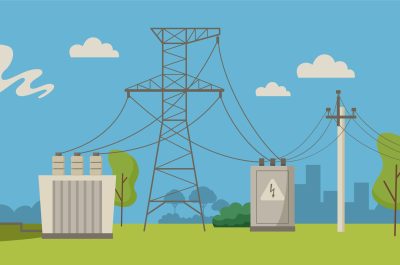Breaking down the financeability challenge
In each region of the national electricity market (NEM) there is one transmission business that has the license to build, own and operate transmission infrastructure. As we enter a new era of significant infrastructure development, these businesses are experiencing new problems, such as raising capital to finance growth while maintaining investment grade creditworthiness. We call this issue the financeability of projects. Here, we have attempted to provide a simplified explainer for this complex challenge.
Transmission businesses are natural monopolies – it doesn’t make sense to have multiple sets of power lines competing to take energy to your house. The revenue transmission businesses can earn and the prices they can charge are accordingly regulated by the Australian Energy Regulator (AER). When setting revenues for transmission businesses, the AER considers how a benchmark efficient business might behave. The AER allows the business to recover its operating costs, a return on its assets and a return of some of its capital in those assets (they don’t last forever). Stepping through each category in a little more detail:
- The revenue allowed for operating expenses is the efficient cost assessed by the AER
- The return on the asset base is set on the basis that 40 per cent of the capital tied up in the assets is from equity (cash from the owners) and 60 per cent of the capital is from debt (cash from the banks),
- The return of the asset base is calculated as a straight line depreciated, for example a $50,000 asset with a life of 50 years then the investment would be returned to the transmission business at a rate of $1,000 per year in real terms.
The energy market is changing rapidly. The shift to a net-zero economy requires significant investment in transmission, including several large projects in quick succession. Some transmission businesses will need to double the value of their assets in around a decade. It is a challenge not before seen in the history of the energy market.
Transmission businesses building new assets of moderate to large scale is manageable. This is their business as usual. Let’s take the example of a $50 million new network project:
| Asset value | Equity return | Debt return | Return of investment | Total revenue / return | Revenue relative to debt | |
| First year | $50 million | $1.4 million | $1.5 million | $1 million | $3.9 million | 3.9/30 |
| Last year | $1 million | $28,000 | $30,000 | $1 million | $1.058 million | 1.058/0.6 |
In the early years, the asset is a drag on cash-flow. In the later years it contributes positively (see revenue relative to debt). The initial drag on cashflow is not a big problem because the business has a large portfolio of assets of various ages. They all even out, more or less.
But what happens if a project, or series of projects, is very large relative to the existing business?
In this case the cashflow of the business comes under significant pressure in the early years of the asset’s life. The reduced cashflow relative to the debt costs of the business creates an increased risk that the business may find itself unable to pay its obligations when they fall due. This increases the likelihood of a credit downgrade, which is an event any business tries hard to avoid. Ratings agencies assess the transmission business’ creditworthiness (riskiness) so that debt providers know the level of risk they are taking when lending to it. A credit downgrade will generally give lenders the right to back out of their lending deal or charge more for their lending (which is appropriate because the risk they are taking has changed).
This is the heart of the financeability issue – new projects that are so large when compared with the existing business that the financial metrics underpinning the creditworthiness of the business come under pressure. Credit ratings agencies will generally allow some latitude on these metrics because the industry is safe and predictably regulated, but this latitude is finite.
Businesses can also give the ratings agencies more comfort on creditworthiness by altering their structure, such as by increasing equity relative to debt. This can only go so far given the regulatory model assumes a 40 per cent equity share and there is a limit to how much additional equity will be willingly provided to ensure a large project goes ahead.
There are other issues that could arise and compound the financeability issue, such as:
- Rate of equity returns – the equity return may not be high enough attract equity into significant projects, particularly if the risks are high.
- Rate of debt returns – the debt return (which is set by a historical average) may not be sufficient if the prevailing cost of debt is higher when the business is raising significant capital to deliver its new projects.
Neither of these is strictly a financeability issue of the kind discussed here. They are potential issues with the rate of return. The solution to these issues is to adjust returns so that equity holders get paid an appropriate and efficient return for the risks they are taking and so that the business is able to recover sufficient revenue to meet its efficient debt costs.
The financeability issue on the other hand is all about cashflow. The appropriate solution is to adjust the cashflow profile for the largest projects so in the early years a greater portion of the asset cost is returned to the transmission business through depreciation, and in the later years a lower portion is returned. The depreciation profile is the only adjustment needed. With this approach, over the life of the asset customers are paying no more and no less in real terms than they would if the depreciation profile was the standard straight line. However, near term customers will pay relatively more than later customers.
It is important to get the approach to setting the depreciation profile right. Without being overly definitive, the approach should:
- provide sufficient certainty for capital providers (equity and debt) to finance the project, noting this may be needed earlier than the main approval for a business to recover revenue from customers because significant work is done before this time
- adjust depreciation profiles only so far as is needed to finance the project without risking a credit downgrade, and
- balance the interests of near term and later customers, noting that varying depreciation will mean near term customers pay relatively more and these same customers would also be the most impacted by a delay to the project.
The current regulatory arrangements don’t allow the energy regulator sufficient flexibility to set depreciation profiles in a way that allows businesses to efficiently raise capital for very large projects without the risk of a credit downgrade. The issue has been recognised by the AEMC in its recent stage 2 final report of the Transmission planning and investment review.
In the short term the federal Government’s rewiring the nation fund can help to address this and other challenges. Regardless, it is important to move quickly to implement enduring arrangements and to take the time to get a solution that works in practice. With sensible changes the regulatory framework for large transmission investments should be able to facilitate large projects without government help in the future. We look forward to continued collaboration with the AEMC and stakeholders as we navigate toward a solution.


